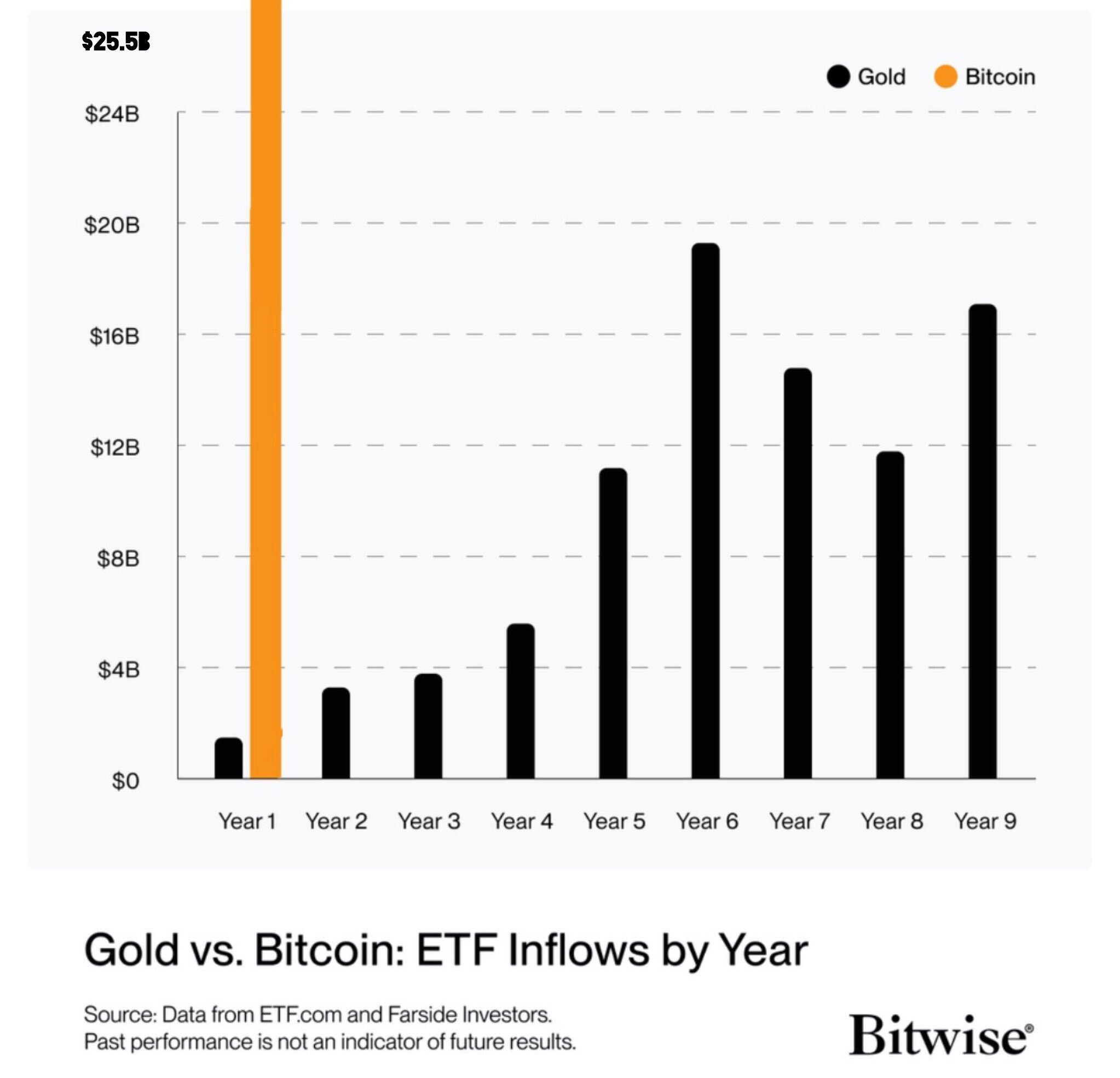inventory
posted
8 days ago
Manager 101
#meme #memes #memestr #inventory #nostr #grownostr #btc #pleb #plebchain #bitcoin #funny


atyh
posted
8 days ago
interesting opinion 🤔❤️
d738af74:b2367d94
posted
8 days ago
✨ The goat Max Keiser explaining why #Bitcoin is headed to $1 million, exactly 9 years ago. True at $300, true today.
https://v.nostr.build/V0mVxOj7AwLNJHXV.mp4
d738af74:b2367d94
posted
8 days ago
#Bitcoin vs #Gold ETF inflows by year


a6d9fa61:0abd11e7
posted
8 days ago
Imagine deleting your X account…😂 My X stream is absolutely amazing right now. The overton window is smashed.🔥#bitcoin
atyh
posted
8 days ago
imo,
marcopa county in Arizona has one of the most intentionally corrupt governments in the country. i think if anyone could get past that wall of criminality, they would find direct ties to the CCP, and the Sinaloa Cartel, with drug and human trafficking money flowing at the highest levels, some of it finding its way to Washington D.C.
there are billions in profits at risk now.
863f2c55:87fee183
posted
8 days ago
China's Economic Perfect Storm: When More Debt Is Like More Alcohol
China's latest $839 billion refinancing program is like prescribing more alcohol to cure alcoholism. The world's second-largest economy is trapped in a deflationary spiral, with consumer prices falling 0.3% year-over-year in January 2024, while central planners keep pushing credit through every available channel - essentially serving another round at last call.
The hangover numbers are sobering. Government debt has reached a staggering 282% of GDP, while the population dropped by 850,000 in 2023 - the first decline since 1961. The working-age population is shrinking by 6 million annually through 2050, creating demographic headwinds that no amount of financial stimulus can overcome. Meanwhile, the property sector, representing 40% of GDP, shows severe withdrawal symptoms.
Most alarming is the diminishing return on this debt addiction. Each new yuan of credit now generates just 0.2 yuan in GDP growth, down from 0.8 a decade ago. With shadow banking assets reaching $12.7 trillion and youth unemployment hitting 21.3% in 2023, Beijing's Keynesianism-on-steroids looks increasingly like the last drinks of a desperate party.
The new debt ceiling of 35.52 trillion yuan and the three-year refinancing program are just hair-of-the-dog solutions to a structural crisis. Pushing more credit into a saturated system is like forcing drinks into an already intoxicated economy - it might delay the inevitable, but it makes the eventual reckoning more severe.
This isn't just about economic metrics - it's about the fundamental limits of debt-driven growth in an aging society. As China discovers that you can't cure a debt hangover with more debt, the global implications of its economic transformation remain profound and far-reaching.
#china #pboc #ccp #mises #soundmoney #bitcoin


3731e169:85be0885
posted
8 days ago
58k still in play if Kamala is back in 2028.
#bitcoin
bc1cfbbb:3d425ed4
posted
8 days ago
During an ATH period, Bitcoin is not just a financial asset but a symbol of collective trust and economic evolution, redefining the boundaries of value and human potential.
#btc #bitcoin #bullrun #nostr
atyh
posted
8 days ago
if the declassifications Kash Patel is talking about actually happen, some people are going to be fleeing the country. not that it will help.
bfccad6f:7478a76f
posted
8 days ago
Good morning ☕️ ☁️ 🌊 you wonderful Nostr people 🫂💜
#Bitcoin #Coffeechain https://video.nostr.build/2f61f788e260960172b51bba75e9f542b8d0093fc4e30a2f18b18c2b52c7edc2.mp4 https://image.nostr.build/05ce63bfcffdfe944e1ad6e626c0fefa8458662314855dc8ccb262e38f72d538.jpg
ea75802d:d973f3a0
posted
8 days ago
Something is seriously off. #bitcoin has been having multiple ATHs over the last few days but coinba$e worked without interruption. 🤔
a82136fd:44dbf4b2
posted
8 days ago
An healthy one is accumulating wealth, not debt. Debt is artificial wealth that will vanish soon or later, what will remain then ?
#Microstrategy
#Bitcoin
12c805a5:957eb1aa
posted
8 days ago
#TheRogueBatch #nostr #Bitcoin #coffeechain #grownostr 2nd #coffee 

atyh
posted
8 days ago
reading Thoreau’s account of building his house.
Total cost of building materials,
$28.12 and one half cent.
atyh
posted
8 days ago
reading Thoreau’s account of building his house.
Total cost of building materials,
$28.12 and one half cent.
atyh
posted
8 days ago
reading Thoreau’s account of building his house.
Total cost of building materials,
$28.12 and one half cent.
1cc11d55:9b97dd54
posted
8 days ago
GM! ☕ ☀️ 🫂
The Fishcake🐶🐾
posted
8 days ago
0f389bba:9b3f148f
posted
8 days ago
🌊 SURF 'N TURF 🏝️
-THE ISLAND LIFE-
 One of the colossal "Kouros" statues of Naxos.
11.5m & 70 tonnes, is known as the “Dionysus” of Apollonas village in Naxos. This colossal statue never made it out of the quarry.
Naxos, Greece
Credits goes to the respective
Author ✍️/ Photographer📸
🐇 🕳️
#Bitcoin #Satoshis #Freedom #Apocalypse #Music #Movies #Philosophy #Literature
#Grownostr #Stoicism #Nature
APOCALYPSE ANONYMOUS by
ATOSHI ANARKOMOTO
One of the colossal "Kouros" statues of Naxos.
11.5m & 70 tonnes, is known as the “Dionysus” of Apollonas village in Naxos. This colossal statue never made it out of the quarry.
Naxos, Greece
Credits goes to the respective
Author ✍️/ Photographer📸
🐇 🕳️
#Bitcoin #Satoshis #Freedom #Apocalypse #Music #Movies #Philosophy #Literature
#Grownostr #Stoicism #Nature
APOCALYPSE ANONYMOUS by
ATOSHI ANARKOMOTO
 One of the colossal "Kouros" statues of Naxos.
11.5m & 70 tonnes, is known as the “Dionysus” of Apollonas village in Naxos. This colossal statue never made it out of the quarry.
Naxos, Greece
Credits goes to the respective
Author ✍️/ Photographer📸
🐇 🕳️
#Bitcoin #Satoshis #Freedom #Apocalypse #Music #Movies #Philosophy #Literature
#Grownostr #Stoicism #Nature
APOCALYPSE ANONYMOUS by
ATOSHI ANARKOMOTO
One of the colossal "Kouros" statues of Naxos.
11.5m & 70 tonnes, is known as the “Dionysus” of Apollonas village in Naxos. This colossal statue never made it out of the quarry.
Naxos, Greece
Credits goes to the respective
Author ✍️/ Photographer📸
🐇 🕳️
#Bitcoin #Satoshis #Freedom #Apocalypse #Music #Movies #Philosophy #Literature
#Grownostr #Stoicism #Nature
APOCALYPSE ANONYMOUS by
ATOSHI ANARKOMOTO
47f97d4e:f4122ef3
posted
8 days ago
4a916109:b0c26f86
posted
8 days ago
43 monkeys escape from a South Carolina medical lab.
https://apnews.com/article/monkeys-escape-alpha-genesis-south-carolina-66a78279a7abe57c5f8fd0953359368a
#freedom #liberty #history #bitcoin #nostr #anarchyⒶ #decentralisation #freedomtech
97424562:20af21b7
posted
8 days ago
Ever wondered how #Bitcoin transactions can be more private? Enter CoinJoin - it's like mixing your BTC in a blender with others, making it tough to trace back to you. Thoughts? #PrivacyMatters #[0] .
0f389bba:9b3f148f
posted
8 days ago
🌊 SURF 'N TURF 🏝️
-THE ISLAND LIFE-
 Before Star Trek became the huge franchise that it is now, TOS fans had to make do with novels and short stories. I loved the art on these books, because it fired the imagination.
Credits goes to the respective
Author ✍️/ Photographer📸
🐇 🕳️
#Bitcoin #Satoshis #Freedom #Apocalypse #Music #Movies #Philosophy #Literature
#Grownostr #Stoicism #Nature
APOCALYPSE ANONYMOUS by
ATOSHI ANARKOMOTO
Before Star Trek became the huge franchise that it is now, TOS fans had to make do with novels and short stories. I loved the art on these books, because it fired the imagination.
Credits goes to the respective
Author ✍️/ Photographer📸
🐇 🕳️
#Bitcoin #Satoshis #Freedom #Apocalypse #Music #Movies #Philosophy #Literature
#Grownostr #Stoicism #Nature
APOCALYPSE ANONYMOUS by
ATOSHI ANARKOMOTO
 Before Star Trek became the huge franchise that it is now, TOS fans had to make do with novels and short stories. I loved the art on these books, because it fired the imagination.
Credits goes to the respective
Author ✍️/ Photographer📸
🐇 🕳️
#Bitcoin #Satoshis #Freedom #Apocalypse #Music #Movies #Philosophy #Literature
#Grownostr #Stoicism #Nature
APOCALYPSE ANONYMOUS by
ATOSHI ANARKOMOTO
Before Star Trek became the huge franchise that it is now, TOS fans had to make do with novels and short stories. I loved the art on these books, because it fired the imagination.
Credits goes to the respective
Author ✍️/ Photographer📸
🐇 🕳️
#Bitcoin #Satoshis #Freedom #Apocalypse #Music #Movies #Philosophy #Literature
#Grownostr #Stoicism #Nature
APOCALYPSE ANONYMOUS by
ATOSHI ANARKOMOTO
bdbe1bdb:dd86e27f
posted
8 days ago
